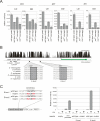A functional genomics strategy reveals clockwork orange as a transcriptional regulator in the Drosophila circadian clock
- PMID: 17578908
- PMCID: PMC1899476
- DOI: 10.1101/gad.1552207
A functional genomics strategy reveals clockwork orange as a transcriptional regulator in the Drosophila circadian clock
Abstract
The Drosophila circadian clock consists of integrated autoregulatory feedback loops, making the clock difficult to elucidate without comprehensively identifying the network components in vivo. Previous studies have adopted genome-wide screening for clock-controlled genes using high-density oligonucleotide arrays that identified hundreds of clock-controlled genes. In an attempt to identify the core clock genes among these candidates, we applied genome-wide functional screening using an RNA interference (RNAi) system in vivo. Here we report the identification of novel clock gene candidates including clockwork orange (cwo), a transcriptional repressor belonging to the basic helix-loop-helix ORANGE family. cwo is rhythmically expressed and directly regulated by CLK-CYC through canonical E-box sequences. A genome-wide search for its target genes using the Drosophila genome tiling array revealed that cwo forms its own negative feedback loop and directly suppresses the expression of other clock genes through the E-box sequence. Furthermore, this negative transcriptional feedback loop contributes to sustaining a high-amplitude circadian oscillation in vivo. Based on these results, we propose that the competition between cyclic CLK-CYC activity and the adjustable threshold imposed by CWO keeps E-box-mediated transcription within the controllable range of its activity, thereby rendering a Drosophila circadian clock capable of generating high-amplitude oscillation.
Figures






Similar articles
-
Clockwork Orange is a transcriptional repressor and a new Drosophila circadian pacemaker component.Genes Dev. 2007 Jul 1;21(13):1675-86. doi: 10.1101/gad.1552607. Epub 2007 Jun 19. Genes Dev. 2007. PMID: 17578907 Free PMC article.
-
CLOCKWORK ORANGE Enhances PERIOD Mediated Rhythms in Transcriptional Repression by Antagonizing E-box Binding by CLOCK-CYCLE.PLoS Genet. 2016 Nov 4;12(11):e1006430. doi: 10.1371/journal.pgen.1006430. eCollection 2016 Nov. PLoS Genet. 2016. PMID: 27814361 Free PMC article.
-
The clockwork orange Drosophila protein functions as both an activator and a repressor of clock gene expression.J Biol Rhythms. 2008 Apr;23(2):103-16. doi: 10.1177/0748730407313817. J Biol Rhythms. 2008. PMID: 18375860
-
Circadian clocks: a tale of two feedback loops.Cell. 2003 Feb 7;112(3):284-6. doi: 10.1016/s0092-8674(03)00076-x. Cell. 2003. PMID: 12581517 Review.
-
Transcriptional feedback loop regulation, function, and ontogeny in Drosophila.Cold Spring Harb Symp Quant Biol. 2007;72:437-44. doi: 10.1101/sqb.2007.72.009. Cold Spring Harb Symp Quant Biol. 2007. PMID: 18419302 Free PMC article. Review.
Cited by
-
Analysis of cycle gene expression in Aedes aegypti brains by in situ hybridization.PLoS One. 2013;8(1):e52559. doi: 10.1371/journal.pone.0052559. Epub 2013 Jan 2. PLoS One. 2013. PMID: 23300979 Free PMC article.
-
The molecular clockwork of the fire ant Solenopsis invicta.PLoS One. 2012;7(11):e45715. doi: 10.1371/journal.pone.0045715. Epub 2012 Nov 13. PLoS One. 2012. PMID: 23152747 Free PMC article.
-
Peripheral circadian rhythms and their regulatory mechanism in insects and some other arthropods: a review.J Comp Physiol B. 2012 Aug;182(6):729-40. doi: 10.1007/s00360-012-0651-1. Epub 2012 Feb 12. J Comp Physiol B. 2012. PMID: 22327195 Review.
-
How Many Clocks, How Many Times? On the Sensory Basis and Computational Challenges of Circadian Systems.Front Behav Neurosci. 2018 Sep 11;12:211. doi: 10.3389/fnbeh.2018.00211. eCollection 2018. Front Behav Neurosci. 2018. PMID: 30258357 Free PMC article. Review.
-
Diurnal protein oscillation profiles in Drosophila head.FEBS Lett. 2018 Nov;592(22):3736-3749. doi: 10.1002/1873-3468.13267. Epub 2018 Oct 30. FEBS Lett. 2018. PMID: 30311939 Free PMC article.
References
-
- Allada R., White N.E., So W.V., Hall J.C., Rosbash M., White N.E., So W.V., Hall J.C., Rosbash M., So W.V., Hall J.C., Rosbash M., Hall J.C., Rosbash M., Rosbash M. A mutant Drosophila homolog of mammalian Clock disrupts circadian rhythms and transcription of period and timeless. Cell. 1998;93:791–804. - PubMed
-
- Blau J., Young M.W., Young M.W. Cycling vrille expression is required for a functional Drosophila clock. Cell. 1999;99:661–671. - PubMed
-
- Cawley S., Bekiranov S., Ng H.H., Kapranov P., Sekinger E.A., Kampa D., Piccolboni A., Sementchenko V., Cheng J., Williams A.J., Bekiranov S., Ng H.H., Kapranov P., Sekinger E.A., Kampa D., Piccolboni A., Sementchenko V., Cheng J., Williams A.J., Ng H.H., Kapranov P., Sekinger E.A., Kampa D., Piccolboni A., Sementchenko V., Cheng J., Williams A.J., Kapranov P., Sekinger E.A., Kampa D., Piccolboni A., Sementchenko V., Cheng J., Williams A.J., Sekinger E.A., Kampa D., Piccolboni A., Sementchenko V., Cheng J., Williams A.J., Kampa D., Piccolboni A., Sementchenko V., Cheng J., Williams A.J., Piccolboni A., Sementchenko V., Cheng J., Williams A.J., Sementchenko V., Cheng J., Williams A.J., Cheng J., Williams A.J., Williams A.J., et al. Unbiased mapping of transcription factor binding sites along human chromosomes 21 and 22 points to widespread regulation of noncoding RNAs. Cell. 2004;116:499–509. - PubMed
-
- Ceriani M.F., Hogenesch J.B., Yanovsky M., Panda S., Straume M., Kay S.A., Hogenesch J.B., Yanovsky M., Panda S., Straume M., Kay S.A., Yanovsky M., Panda S., Straume M., Kay S.A., Panda S., Straume M., Kay S.A., Straume M., Kay S.A., Kay S.A. Genome-wide expression analysis in Drosophila reveals genes controlling circadian behavior. J. Neurosci. 2002;22:9305–9319. - PMC - PubMed
-
- Claridge-Chang A., Wijnen H., Naef F., Boothroyd C., Rajewsky N., Young M.W., Wijnen H., Naef F., Boothroyd C., Rajewsky N., Young M.W., Naef F., Boothroyd C., Rajewsky N., Young M.W., Boothroyd C., Rajewsky N., Young M.W., Rajewsky N., Young M.W., Young M.W. Circadian regulation of gene expression systems in the Drosophila head. Neuron. 2001;32:657–671. - PubMed
Publication types
MeSH terms
Substances
Grants and funding
LinkOut - more resources
Full Text Sources
Molecular Biology Databases
